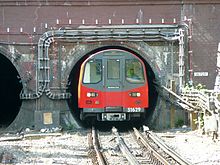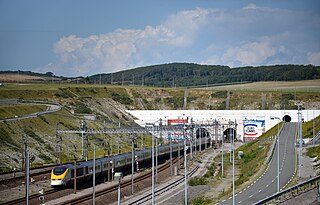
The Channel Tunnel, sometimes referred to informally as the Chunnel, is a 50.46-kilometre (31.35 mi) undersea railway tunnel, opened in 1994, that connects Folkestone with Coquelles beneath the English Channel at the Strait of Dover. It is the only fixed link between the island of Great Britain and the European mainland. At its lowest point, it is 75 metres (246 ft) below the sea bed and 115 metres (377 ft) below sea level. At 37.9 kilometres (23.5 mi), it has the longest underwater section of any tunnel in the world and is the third-longest railway tunnel in the world. The speed limit for trains through the tunnel is 160 kilometres per hour (99 mph). The tunnel is owned and operated by Getlink, formerly Groupe Eurotunnel.

A tunnel is an underground or undersea passageway. It is dug through surrounding soil, earth or rock, or laid under water, and is perfectly enclosed except for the two portals common at each end. A pipeline is not a tunnel, though some recent tunnels have used immersed tube construction techniques rather than traditional tunnel boring methods.
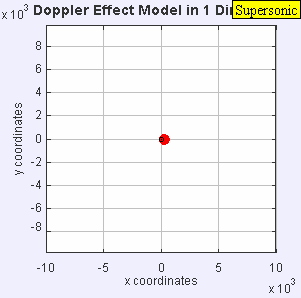
A sonic boom is a sound associated with shock waves created when an object travels through the air faster than the speed of sound. Sonic booms generate enormous amounts of sound energy, sounding similar to an explosion or a thunderclap to the human ear.
Automotive aerodynamics is the study of the aerodynamics of road vehicles. Its main goals are reducing drag and wind noise, minimizing noise emission, and preventing undesired lift forces and other causes of aerodynamic instability at high speeds. Air is also considered a fluid in this case. For some classes of racing vehicles, it may also be important to produce downforce to improve traction and thus cornering abilities.

A slipstream is a region behind a moving object in which a wake of fluid is moving at velocities comparable to that of the moving object, relative to the ambient fluid through which the object is moving. The term slipstream also applies to the similar region adjacent to an object with a fluid moving around it. "Slipstreaming" or "drafting" works because of the relative motion of the fluid in the slipstream.

Downforce is a downwards lift force created by the aerodynamic features of a vehicle. If the vehicle is a car, the purpose of downforce is to allow the car to travel faster by increasing the vertical force on the tires, thus creating more grip. If the vehicle is a fixed-wing aircraft, the purpose of the downforce on the horizontal stabilizer is to maintain longitudinal stability and allow the pilot to control the aircraft in pitch.

Elevators are flight control surfaces, usually at the rear of an aircraft, which control the aircraft's pitch, and therefore the angle of attack and the lift of the wing. The elevators are usually hinged to the tailplane or horizontal stabilizer. They may be the only pitch control surface present, and are sometimes located at the front of the aircraft or integrated into a rear "all-moving tailplane", also called a slab elevator or stabilator.

An inlet manifold or intake manifold is the part of an internal combustion engine that supplies the fuel/air mixture to the cylinders. The word manifold comes from the Old English word manigfeald and refers to the multiplying of one (pipe) into many.

Mach tuck is an aerodynamic effect whereby the nose of an aircraft tends to pitch downward as the airflow around the wing reaches supersonic speeds. This diving tendency is also known as tuck under. The aircraft will first experience this effect at significantly below Mach 1.
Cylinder head porting refers to the process of modifying the intake and exhaust ports of an internal combustion engine to improve their air flow. Cylinder heads, as manufactured, are usually suboptimal for racing applications due to being designed for maximum durability. Ports can be modified for maximum power, minimum fuel consumption, or a combination of the two, and the power delivery characteristics can be changed to suit a particular application.
The stack effect or chimney effect is the movement of air into and out of buildings through unsealed openings, chimneys, flue-gas stacks, or other containers, resulting from air buoyancy. Buoyancy occurs due to a difference in indoor-to-outdoor air density resulting from temperature and moisture differences. The result is either a positive or negative buoyancy force. The greater the thermal difference and the height of the structure, the greater the buoyancy force, and thus the stack effect. The stack effect helps drive natural ventilation, air infiltration, and fires.

The Tatra 77 (T77) is one of the first serial-produced, truly aerodynamically-designed automobiles, produced by Czechoslovakian company Tatra from 1934 to 1938. It was developed by Hans Ledwinka and Paul Jaray, the Zeppelin aerodynamic engineer. Launched in 1934, the Tatra 77 is a coach-built automobile, constructed on a platform chassis with a pressed box-section steel backbone rather than Tatra's trademark tubular chassis, and is powered by a 60 horsepower (45 kW) rear-mounted 2.97-litre air-cooled V8 engine, in later series increased to a 75 horsepower (56 kW) 3.4-litre engine. It possessed advanced engineering features, such as overhead valves, hemispherical combustion chambers, a dry sump, fully independent suspension, rear swing axles and extensive use of lightweight magnesium alloy for the engine, transmission, suspension and body. The average drag coefficient of a 1:5 model of Tatra 77 was recorded as 0.2455. The later model T77a, introduced in 1935, has a top speed of over 150 km/h (93 mph) due to its advanced aerodynamic design which delivers an exceptionally low drag coefficient of 0.212, although some sources claim that this is the coefficient of a 1:5 scale model, not of the car itself. Recent article confirmed the Tatra 77/77a drag coefficient for real full-size car as 0.36.
In car design, ground effect is a series of effects which have been exploited in automotive aerodynamics to create downforce, particularly in racing cars. This has been the successor to the earlier dominant aerodynamic focus on streamlining. The international Formula One series and American racing IndyCars employ ground effects in their engineering and designs. Similarly, they are also employed in other racing series to some extent; however, across Europe, many series employ regulations to limit its effectiveness on safety grounds.

A fan is a powered machine used to create a flow of air. A fan consists of a rotating arrangement of vanes or blades, generally made of wood, plastic, or metal, which act on the air. The rotating assembly of blades and hub is known as an impeller, rotor, or runner. Usually, it is contained within some form of housing, or case. This may direct the airflow, or increase safety by preventing objects from contacting the fan blades. Most fans are powered by electric motors, but other sources of power may be used, including hydraulic motors, handcranks, and internal combustion engines.
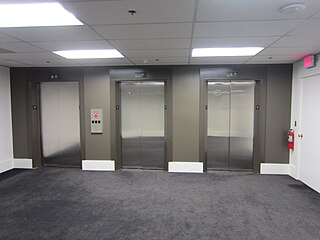
An elevator or lift is a machine that vertically transports people or freight between levels. They are typically powered by electric motors that drive traction cables and counterweight systems such as a hoist, although some pump hydraulic fluid to raise a cylindrical piston like a jack.
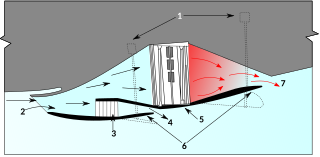
The Meredith effect is a phenomenon whereby the aerodynamic drag produced by a cooling radiator may be offset by careful design of the cooling duct such that useful thrust is produced by the expansion of the hot air in the duct. The effect was discovered in the 1930s and became more important as the speeds of piston-engined aircraft increased over the next decade.
Ground vibration boom is a phenomenon of very large increase in ground vibrations generated by high-speed railway trains travelling at speeds higher than the velocity of Rayleigh surface waves in the supporting ground.

Cross ventilation is a natural phenomenon where wind, fresh air or a breeze enters upon an opening, such as a window, and flows directly through the space and exits through an opening on the opposite side of the building. This produces a cool stream of air and as well as a current across the room from the exposed area to the sheltered area.
The Chiltern Tunnel is a high-speed railway tunnel currently under construction in Buckinghamshire and Hertfordshire, England, and will upon completion carry the High Speed 2 (HS2) railway line under the Chiltern Hills. The twin-bore tunnels, which are 16.04 km long, will be the longest on the HS2 line. Each tunnel will also have additional 220 m (720 ft) entry and 135 m (443 ft) exit perforated concrete portals to reduce sudden changes in air pressure and subsequent noise.
This glossary of automotive terms is a list of definitions of terms and concepts related to automobiles, including their parts, operation, and manufacture, as well as automotive engineering, auto repair, and the automotive industry in general. For more specific terminology regarding the design and classification of various automobile styles, see Glossary of automotive design; for terms related to transportation by road, see Glossary of road transport terms; for competitive auto racing, see Glossary of motorsport terms.


